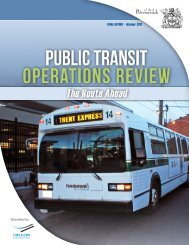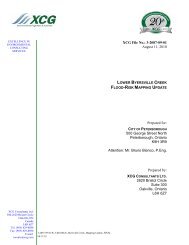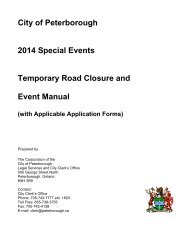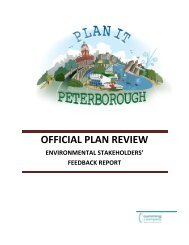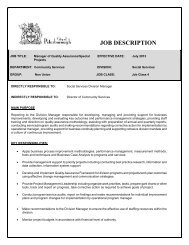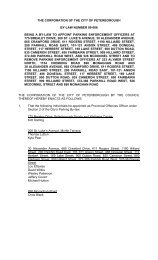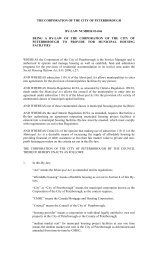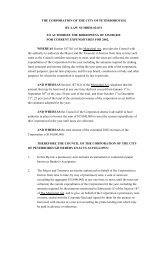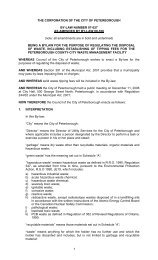Thompson Creek Flood Study Report - City of Peterborough
Thompson Creek Flood Study Report - City of Peterborough
Thompson Creek Flood Study Report - City of Peterborough
Create successful ePaper yourself
Turn your PDF publications into a flip-book with our unique Google optimized e-Paper software.
<strong>Thompson</strong> <strong>Creek</strong> Detailed <strong>Flood</strong> Reduction <strong>Study</strong><br />
<strong>City</strong> <strong>of</strong> <strong>Peterborough</strong><br />
<strong>Thompson</strong> <strong>Creek</strong> due to the damping effect <strong>of</strong> the storage upstream <strong>of</strong> Armour Road.<br />
Hence only the one event was used in the verification process.<br />
Table 4.4.3<br />
Comparison <strong>of</strong> Observed and Simulated Flows for June 1, 2006 Event<br />
Location<br />
Rainfall<br />
(mm)<br />
Observed<br />
Flow (m 3 /s)<br />
Simulated<br />
Flow (m 3 /s)<br />
Scollard/Francis Stewart Sewer Outlet 29.3 0.75 0.78<br />
<strong>Thompson</strong> <strong>Creek</strong> near Ashdale Cresc. W. 29.3 0.30 0.29<br />
4.4.2 HEC-RAS Modelling <strong>of</strong> <strong>Thompson</strong> <strong>Creek</strong><br />
The HEC-RAS model calculates water levels in a creek and its flood plain<br />
corresponding to a set <strong>of</strong> flows. It uses information on the shape, length and roughness<br />
<strong>of</strong> the creek and flood plain and on the size <strong>of</strong> any culverts, bridges, dams, etc. which<br />
cross the creek. The following describes the development <strong>of</strong> the <strong>Thompson</strong> <strong>Creek</strong><br />
HEC-RAS model.<br />
4.4.2.1 Model Development<br />
As discussed in Section 4.2.2, the Otonabee Region Conservation Authority (ORCA)<br />
developed flood plain mapping <strong>of</strong> <strong>Thompson</strong> <strong>Creek</strong> some years ago using an earlier<br />
version <strong>of</strong> HEC-RAS known as HEC-2. Since the existing model was developed prior<br />
to installation <strong>of</strong> several <strong>of</strong> the culverts at the downstream end <strong>of</strong> the creek, it required a<br />
complete review, update and conversion. The existing model was provided to MMM<br />
and was used as a general basis for a new model. In general, the locations <strong>of</strong> the crosssections<br />
used are in similar locations but all have been recoded based on current<br />
topographic information, detailed field surveys <strong>of</strong> the low flow channel and current data<br />
on the water crossings (four sets <strong>of</strong> culverts from the outlet to Armour Road). Drawing<br />
FV-1 shows the location and extent <strong>of</strong> the cross-sections used. The field survey notes<br />
and cross-section plots are included in Appendix I. The model coding is also presented<br />
in Appendix I.<br />
4.4.2.2 Model Verification<br />
Ideally, verification <strong>of</strong> the HEC-RAS model would involve comparing computed water<br />
levels with observed levels along the creek for a significant storm event. Unfortunately,<br />
only limited water level data is available for <strong>Thompson</strong> <strong>Creek</strong>. For the event <strong>of</strong><br />
June 1, 2006, used to verify the hydrologic models, a water level measurement was<br />
available at the downstream flow gauge near Ashdale Crescent West. This indicated<br />
14-06605-01-W01 <strong>City</strong> <strong>of</strong> <strong>Peterborough</strong> 49




